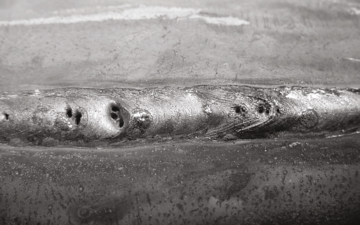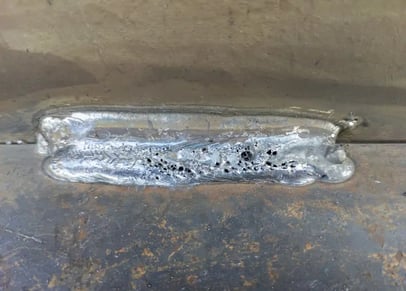Recognizing What is Porosity in Welding: Reasons and Solutions
Recognizing What is Porosity in Welding: Reasons and Solutions
Blog Article
The Scientific Research Behind Porosity: A Comprehensive Overview for Welders and Fabricators
Recognizing the complex devices behind porosity in welding is critical for welders and makers striving for remarkable craftsmanship. From the structure of the base products to the complexities of the welding procedure itself, a wide variety of variables conspire to either aggravate or reduce the presence of porosity.
Understanding Porosity in Welding
FIRST SENTENCE:
Assessment of porosity in welding reveals critical insights right into the integrity and top quality of the weld joint. Porosity, characterized by the presence of cavities or spaces within the weld metal, is a typical concern in welding processes. These gaps, otherwise correctly resolved, can compromise the structural stability and mechanical homes of the weld, bring about potential failures in the completed item.

To detect and quantify porosity, non-destructive testing methods such as ultrasonic screening or X-ray evaluation are usually used. These strategies allow for the recognition of inner flaws without jeopardizing the honesty of the weld. By examining the size, form, and circulation of porosity within a weld, welders can make informed choices to enhance their welding processes and accomplish sounder weld joints.

Variables Influencing Porosity Development
The occurrence of porosity in welding is affected by a myriad of factors, ranging from gas securing efficiency to the details of welding specification setups. Welding criteria, including voltage, existing, travel rate, and electrode kind, additionally effect porosity development. The welding technique utilized, such as gas steel arc welding (GMAW) or protected steel arc welding (SMAW), can influence porosity formation due to variants in heat distribution and gas insurance coverage - What is Porosity.
Effects of Porosity on Weld High Quality
Porosity development substantially endangers the structural stability and mechanical homes of bonded joints. When porosity exists in a weld, it creates gaps or tooth cavities within the product, lowering the overall strength of the joint. These spaces work as stress concentration points, making the weld a lot more prone to fracturing and failing under load. The presence of porosity likewise deteriorates the weld's resistance to deterioration, as the trapped air or gases within the spaces can respond with the surrounding atmosphere, bring about destruction over time. Additionally, porosity can hinder the weld's capability to stand up to stress or effect, additional endangering the general high quality official website and dependability of the bonded framework. In important applications such as aerospace, auto, or architectural building and constructions, where safety and security and durability are paramount, the detrimental effects of porosity on weld top quality can have extreme effects, stressing the value of lessening porosity with proper welding techniques and procedures.
Techniques to Lessen Porosity
To enhance the top quality of welded joints and make sure structural honesty, look at here now welders and fabricators use specific methods focused on decreasing the development of voids and dental caries within the material during the welding procedure. One efficient method to lessen porosity is to ensure appropriate product prep work. This includes extensive cleansing of the base steel to remove any impurities such as this page oil, grease, or dampness that could add to porosity development. Additionally, making use of the suitable welding specifications, such as the appropriate voltage, present, and take a trip rate, is crucial in stopping porosity. Keeping a consistent arc length and angle during welding likewise helps in reducing the chance of porosity.

Utilizing the appropriate welding strategy, such as back-stepping or using a weaving movement, can also assist distribute heat equally and minimize the chances of porosity development. By carrying out these techniques, welders can properly lessen porosity and produce high-quality bonded joints.

Advanced Solutions for Porosity Control
Executing sophisticated innovations and innovative approaches plays an essential role in attaining exceptional control over porosity in welding procedures. One sophisticated solution is making use of advanced gas combinations. Protecting gases like helium or a combination of argon and hydrogen can assist reduce porosity by supplying better arc security and improved gas protection. Additionally, utilizing innovative welding techniques such as pulsed MIG welding or changed atmosphere welding can additionally help alleviate porosity issues.
An additional innovative service includes using innovative welding equipment. As an example, making use of equipment with built-in features like waveform control and sophisticated power resources can boost weld quality and decrease porosity dangers. The application of automated welding systems with exact control over specifications can dramatically decrease porosity defects.
Additionally, integrating sophisticated tracking and evaluation modern technologies such as real-time X-ray imaging or automated ultrasonic screening can aid in identifying porosity early in the welding procedure, allowing for instant rehabilitative actions. On the whole, incorporating these innovative options can greatly boost porosity control and improve the overall high quality of bonded components.
Verdict
To conclude, understanding the scientific research behind porosity in welding is vital for welders and producers to generate premium welds. By determining the factors influencing porosity formation and applying strategies to reduce it, welders can enhance the total weld quality. Advanced services for porosity control can additionally enhance the welding procedure and make certain a solid and trustworthy weld. It is very important for welders to continually educate themselves on porosity and apply finest practices to achieve ideal outcomes.
Report this page